
**This post contains affiliate links**
We interrupt your sanding-hardwood-floors pleasure to bring you...

This hole.
Yep.
My kitchen floor- the one I've been scraping glue off of and sanding down tirelessly? It had a hole in it.
At one time in it's 75 years, the kitchen was set up rather differently than it is now- namely, the sink was in a different place. This hole is probably the hole that a pipe was plumbed through to the sink at one point. And, while it's handy when you're trying to hand tools back and forth to your hubby in the basement while you're upstairs, we didn't really want to keep this hole in the kitchen forever.
As you can see, the hole itself wasn't very even- time and probably less-efficient tools resulted in some jagged edges- not ideal for plugging up an old hole.
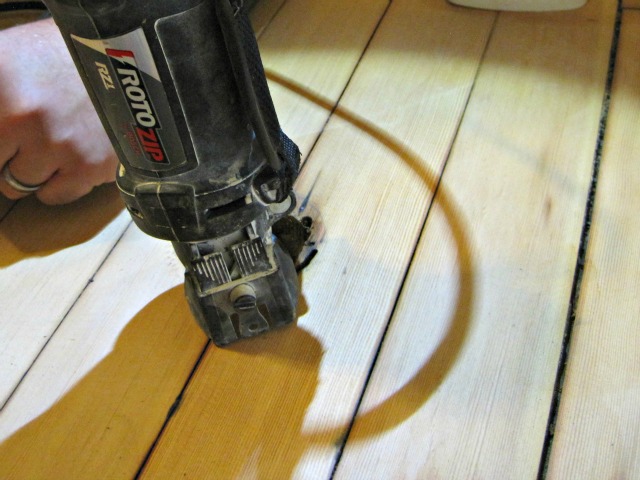
We used a Roto Zip to remove those jagged edges and get the hole to a uniform shape so we could make a plug that would fit tight.
First, my husband found a circular object (you could use the opening of a jar, for example) just a little bigger than our original hole, and traced around the object with a pencil to make a cutting line in a consistent circular shape.

Then we found a piece of scrap lumber that would work to make a plug for the hole. It's recommended that you use the same type of wood for the plug as was used in the floor... but we were on kind of a tight schedule and just wanted to be done... so the we just used a scrap from the garage.
You'll want to start by determining how deeply you'll need to cut into the floor. You want your new hole to be the same depth as your plug- no deeper- to make sure that the finished plug is flush to the existing floor.
To do this, adjust the depth of your RotoZip blade to the same depth as your plug will be (as shown above.)
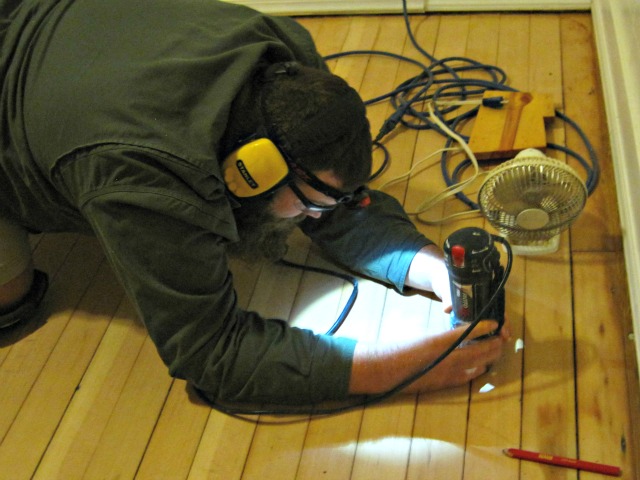
Then, following the outline he'd traced earlier, Trevor used the RotoZip to cut into the floor, cutting just outside the line he traced. (And he of course looked handsome while doing so in his fashionable hearing protection and eye protection).
Rabbit Trail: If you've got a similar schedule to the one we had for this project (the nights-and-weekends plan), I'd really recommend a headlamp. You want to be able to see what you're doing, even in low light and when working at night- and a headlamp is a great asset. We use these ones. A little pricey, but honestly, we use it for everything and it's the best one we've found.

Once he'd gone all the way around the hole he'd traced, he used a screwdriver to remove the debris, and then vacuumed the sawdust out from the new hole.
As you can see, the original hole was smaller than the new one he'd made- this is so the plug will sit in the floor and cover up the hole.
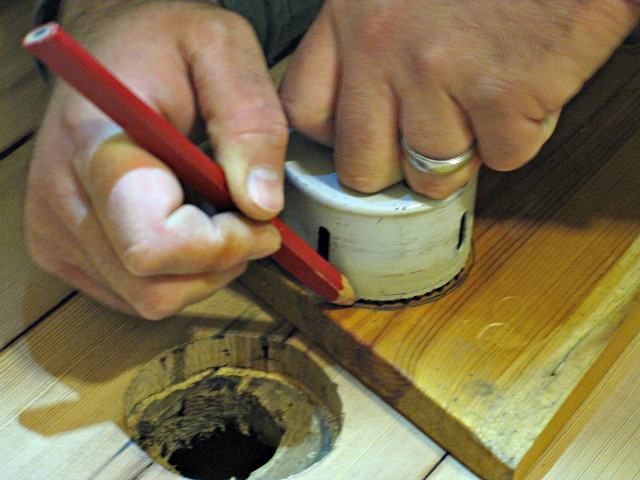
Next, we used the same round object that we'd used to trace the new hole for the floor to trace a plug on our scrap wood.
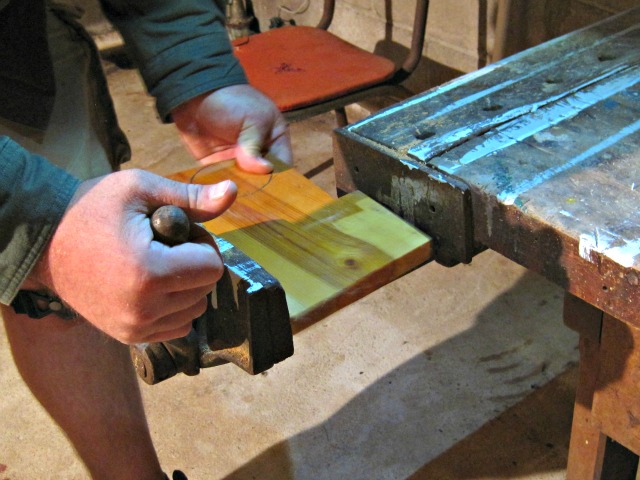
Trevor put the scrap on a vice grip in the basement...

... and then used the RotoZip to cut the plug out of the scrap wood, cutting just inside of the line he traced.

He popped the plug out of the wood, and voila!

We headed back upstairs, and he lined up the plug so the grain of the wood matched with the floor boards.
Then we sanded down the plug a little, making the top of the plug just slightly wider than the bottom. When the plug was small enough to fit tightly into the hole, it was time to glue it down.
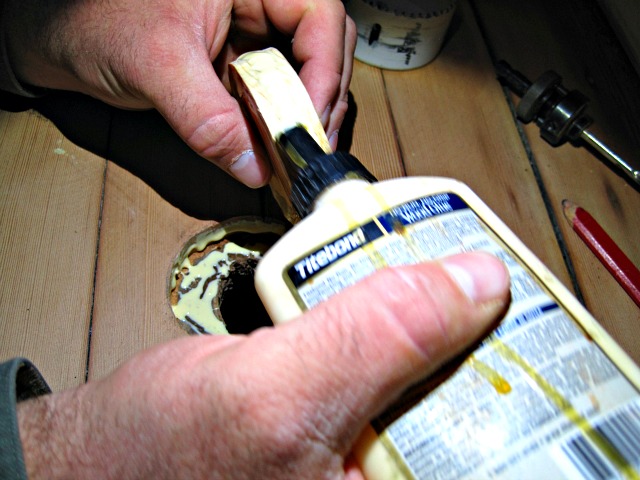
We put wood glue on the base of our hole in the floor, and then also around the sides of the plug, and then put it into place.

We made sure the plug was completely formed to the hole by tapping it in with a hammer (with a piece of scrap lumber over top of the plug so we didn't dent it).
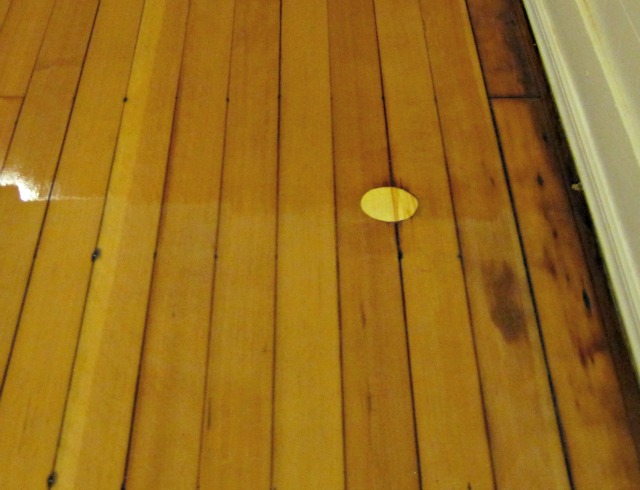
Next, we sanded down the plug and surrounding wood using a handheld belt sander (first with 80-grit to sand the plug flush with the floor, then with 100-grit, and finally with 220-grit sandpaper).
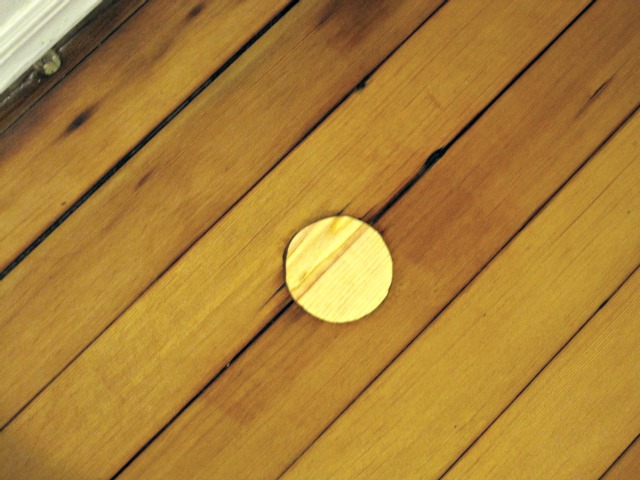
This is what our plug looks like after being varnished with the rest of the floor. As you can see, it is noticeably different from the rest of the floor because we used a different type of wood, but with time and age, it should blend in a little better.
For more about our home renovation projects (including a heck of a lot about this hardwood floor project) you can see all the posts so far here--> Our Farmhouse Remodel
DISCLOSURE: In order for me to support my blogging habit, I may receive monetary compensation or other types of remuneration for my endorsement, recommendation, testimonial and/or link to any products or services from this blog. You may see a full disclosure by clicking on my "About" page. I will only promote products that I use, enjoy, or take a shine to. All opinions and reviews are my own and are not influenced by any compensation I may receive.








Great job fixing the floor! Our home was built in 1850 and we've been slowly renovating it since we bought it. It's a big job but so worth it.
ReplyDeleteThanks for sharing such a wonderful article about wood hole repair.
ReplyDelete